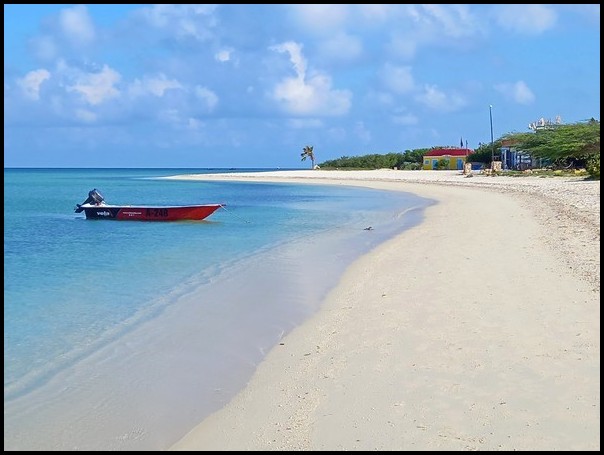
Introduction to Aruba
Aruba is a small flat Caribbean island rimmed by powdery white sand beaches and clear aquamarine sea water. It’s located in the southern Caribbean, just 30 km / 18 miles north of Venezuela. The closest Caribbean island is Curacao, located 50 miles / 80 km east of Aruba.
Aruba is a popular luxury-beach vacation spot, particularly for Americans who account for 80% of the island’s tourism. Aruba is almost continuously sunny, making it a perfect beach vacation destination, year round. There’s rarely any rain. In fact, the average annual rainfall is only 12 inches per year.
Aruba is one of a cluster of three islands, often called the ‘ABC Islands’, for their names: Aruba, Bonaire and Curacao. They were all Dutch colonies for several centuries and are still connected to Netherlands.
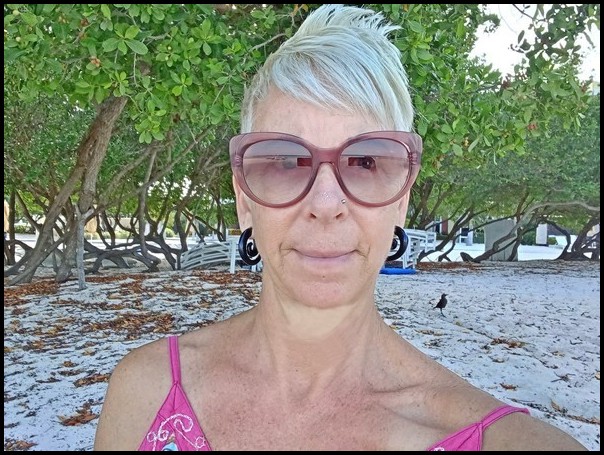
My Visit to Aruba
Years ago I researched all the Caribbean islands, so I knew a bit about Aruba. And of course, I planned to visit one day, though I didn’t have any thoughts of visiting any time soon, let alone this year. After all, I was over on the other side of the world, exploring wonderful Turkey.
However, in July, 2021, a wonderful unexpected opportunity to live on Aruba for two months suddenly fell in my lap. So I quickly changed my travel plans, flew back to Florida for a short family visit, then headed down to sunny Aruba from Florida (where flights to/from are rather cheap).
So, here I am on beautiful Aruba!
I landed in Aruba at the tail end of August and will be looking after a Dutch woman’s apartment and fluffy cat until late October. I wrote more details about How I Ended Up on Aruba here.
Meanwhile, over the next two months I’ll be sharing photos, travel tales and lots of interesting info about this gorgeous Caribbean island nation, so stay tuned!
To kick things off, here’s my introduction to Aruba, much of which I learned from online research and talking to locals during my first week on the island.
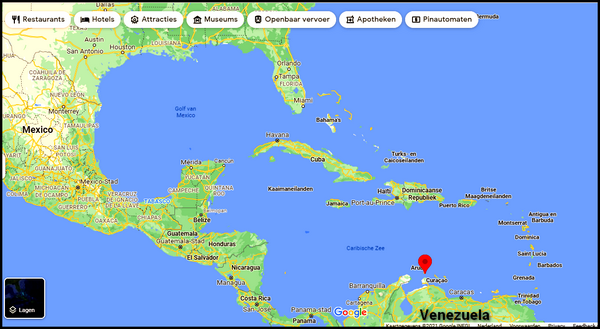
Geography and Climate of Aruba
Aruba is a very small and long, narrow roughly almond-shaped island. It sits at an angle in the Caribbean, running northwest to southeast. From it’s northwestern to southeastern tips, it’s just 20 miles / 35 km. Across, the island is just 6 miles / 10 km at it’s widest point.
The total land area is only 69 miles sq. / 179 km sq. That’s about the size of the tiny European country, Leichtenstein. For a US comparison, Aruba is 15 times smaller than our smallest state, Rhode Island, and about twice the size of the small national park island. Chincoteague, located just off the coast of Virginia.
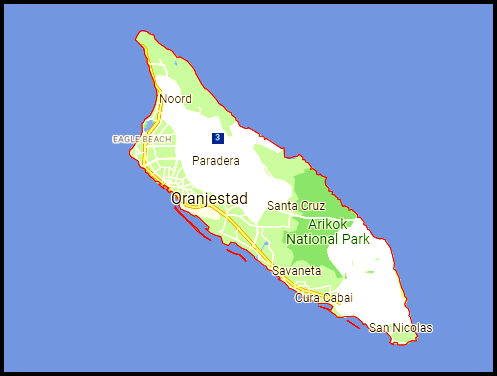
Aruba is essentially little more than a big sandbar. It’s relatively flat, but actually is mostly slightly hilly, particluarly in the interior and along the northeastern side. The highest ‘peak’ is just 617 ft. / 188 M in elevation.
Aruba’s long, flat southwestern coast has a series of wide powdery white sand beaches and calm, shallow bright turquiouse seas. That’s where all the island’s population and development are found: towns, residential areas, hotels and other tourist facilities & activities.
In contrast, the island’s far northern tip, southern end and its long northeastern side have rocky coastlines that are pounded by rough, dangerous waters. These areas of the island have been left mostly in a natural state, occupying about 1/3 of the island in total. Much of that area is part of Arikok National Park.
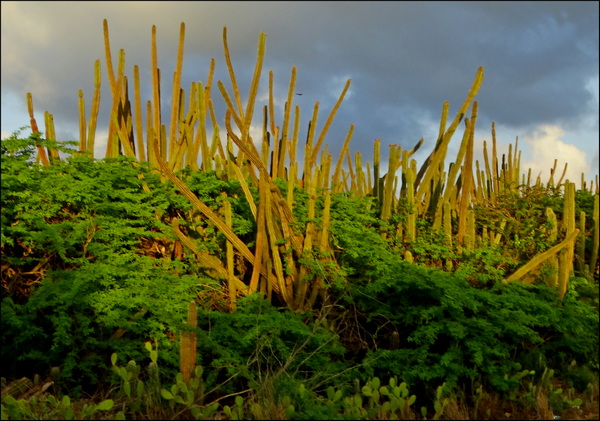
Unlike most Caribbean islands, Aruba has very arid land and vegetation. In fact, Aruba does not have one single river. Technically, it’s classified as a ‘hot semi-arid climate’. Dense stands of house-tall cactii, thorny bushes, scrubby trees, palms and sand-loving vegetation cover the island.
On the other hand, and rather ironically, Aruba’s air is very damp, with humidity levels of 75-85% year-round. The island is also very hot all year, with usual daily highs in the mid-80s to high-90s F / 30-33C and night-time temperatures in the upper 70s-low 80s F / 27-29C. The island is slightly less hot in winter months and slightly hotter in August and September.
Aruba is also almost constantly windy, with the Atlantic trade winds blowing across the island from the northeast. Thankfully, the winds temper the high heat & humidity somewhat, as well as making the island a great spot for wind-surfing, kite-surfing and paragliding.
At one time in Aruba’s history, up to 2/3 of the island was covered in massive aloe vera plantations and Aruba was the world’s largest exporter of aloe. Nowadays, the aloe trade is considerably smaller and tourism has taken over as the main source of income and economic activity. But there the Aloe Farm and Museum detail the island’s historic aloe trade.
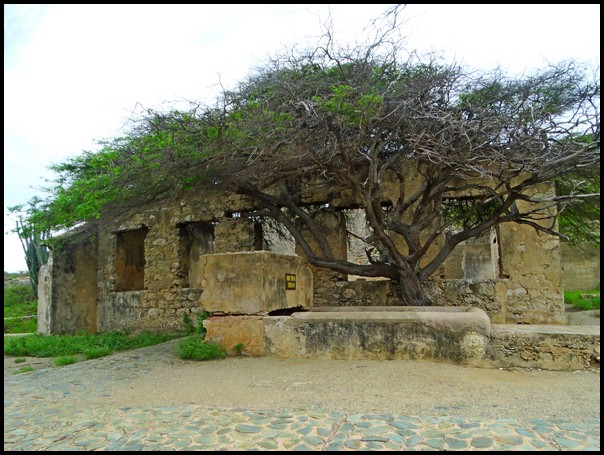
Brief Ancient History of Aruba
Archeaologists have confirmed human activity on Aruba way back to 2000 BC. The earliest identified humans were Arawak Coquieto Amerinduas Indians who migrated up from South America. Over the centuries since then, there’s been a strong connection between Arubans and South Americans.
Fast forward to the heyday centuries of European global exploration, exploitation and colonization (1500s-1800s), Aruba fell first to the Spanish in the early 1500s. The rather brutal Spaniards enslaved the natives, mostly taking them away to work in mines elsewhere since Aruba’s arid conditions and lack of fresh water rendered the island useless for large plantations. The Spanish ‘owned’ Aruba for 135 years.
In 1636. as a result of the Thirty Years War in the early 1600s, the Dutch took over Aruba They soon freed the Arawak natives to farm and graze cattle. The Dutch used the produce & meat to feed themselves and other nearby Dutch colonies.
Aside from a brief 10-year take-over by the British in the early 1800s and by Nazi Germans in the 1940s, Aruba remained a colony of the Netherlands from 1636-1986, most of 350 years.
In the 1800s to early 1900s, Aruba produced phosphate, created aloe vera plantations and mined gold. But the island remained relatively poor and unknown.
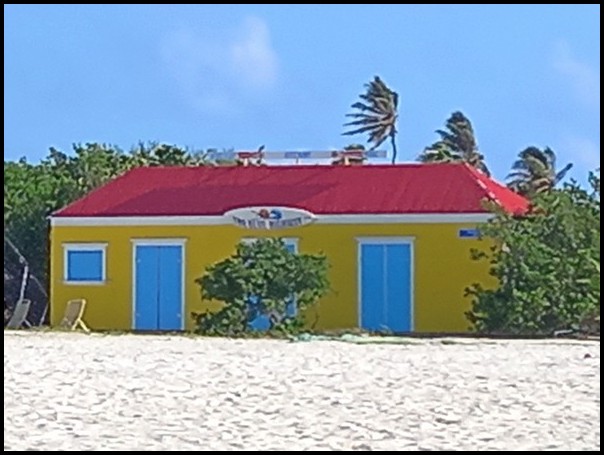
Brief Recent History of Aruba
In 1928, the first oil refinery opened on Aruba, refining crude oil from nearby Venezuelan oil fields. The refineries grew, with several major oil companies involved, until Aruba boasted one of the world’s largest oil refineries. Not surprsingly, this completely transformed Aruba’s economy, wealth and lifestyle. In fact, Aruba quickly became one of the most prosperous islands in the Caribbean.
That continued until the oil refineries closed in 1985, creating another huge change for Aruba. Instantly, the island overall lost 30% of its income, while the government lost 50% of its income.
Lucikly for the islanders and government, tourism quickly began thriving, replacing income from the oil refineries rather smoothly. But an active tourism board had been founded in 1946, promoting tourism over the decades, particularly marketing to Americans. By the 1970s a decent tourist industry was already established.
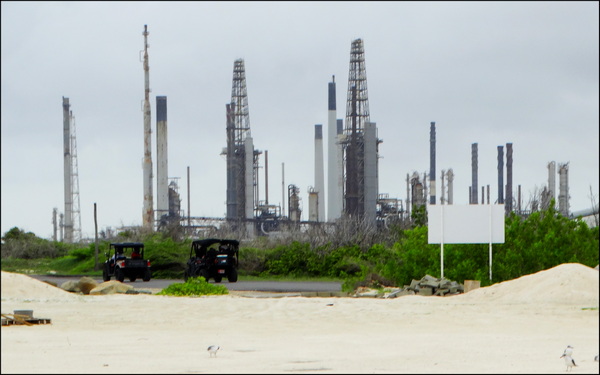
After the refineries closed, the Aruba Tourism Association and the government promoted tourism even more vigorously. As a result, since the 1990s, tourism on Aruba has been booming, along with a large influx of immigrants, mostly from South America and other Caribbean islands, to work in the thriving tourist industry.
Today, Aruba has one of the Caribbean’s largest GDP, estimated at $37,500 US in 2018. That’s along the GDP of the USA and many European countries.
The push for Aruban independence began in 1972, but it took until 1986 for Aruba to gain semi-autonomy as a separate country with its own constitution, flag, coat of arms, currency and control of its domestic affairs.
But Aruba is not completely independent. More exactly, Aruba is currently one of four constituent countries making up the Kingdom of Netherlands. The other three countries are Netherlands, Curacao (neighboring island) and Sint Maarten (a more distant Caribbean island).
Under this arrangement, the Netherlands handles Aruba’s defense and foreign affairs, while the Aruban government governs its own domestic affairs. The rather unusual political system includes a Governor appointed by Netherland’s monarch, a 21-member parliament who are elected directly by Aruban citizens, and a Prime Minister who is, in turn, elected by the Aruban legislature. There’s a Dutch military presence on the island.
Aruba also has two free trade zones with off-shore banking, which makes it a haven for wealthy individuals banking money and for money-laundering.
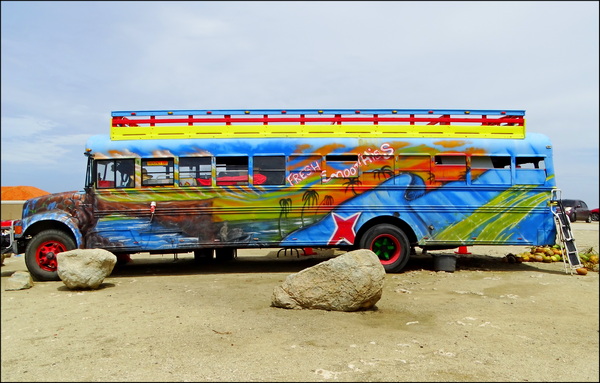
Aruban Culture
As noted above, Aruba’s native population originally migrated from South America circa 1000 BC. They are the Arawak Coquieto Indians. During the Spanish colonial days, African slaves were brought to the island. And then, of course, the Dutch were present for 350 years.
Today’s native population is mostly mestizo, a mix of primarily Arawak, Africans and Dutch. However, a total of over 90 nationalities have migrated to Aruba over the centuries and been incorporated into the Aruban population.
Arubans have their own language called Papamiento. It’s a creole language that includes words from Spanish, Portuguese, Dutch and west African languages. Papamiento is only spoken on Aruba and the two nearby islands of Curacao and Bonaire, though each island has its own version of the language.
Aruba’s official languages are Papamiento and Dutch. Most Arubans today speak three languages: Papamiento, Dutch and English. Many also speak Spanish.
With Aruba’s 350-year occupation by the Netherlands, it’s not surprising that there are also traces of Dutch culture on the island. These include the popular, pastel-colored colonial Dutch buildings in the capital city, Oranjestad, as well as the use of Dutch language, political and educational systems, the presence of the Dutch military, and a few Dutch holidays.
In more recent decades, with the advent of the tourist industry, many Chinese and Indians (from the country India) have migrated to Aruba. I was told that 99% of supermarkets and laundries on Aruba are owned by Chinese; 95% of jewelry and souvenir businesses are owned by Indians; 90% of real estate agents are owned by Dutch; and 95% of tourist industry businesses and workers are Arubans.
Besides Aruba’s diverse mix of residents and citizens, about 1 million tourists per year visit the island, with 80% being American. Most other tourists hail from South America and Europe. In addition, over 800,000 cruise ship passengers visit Aruba each year (pre-Covid).
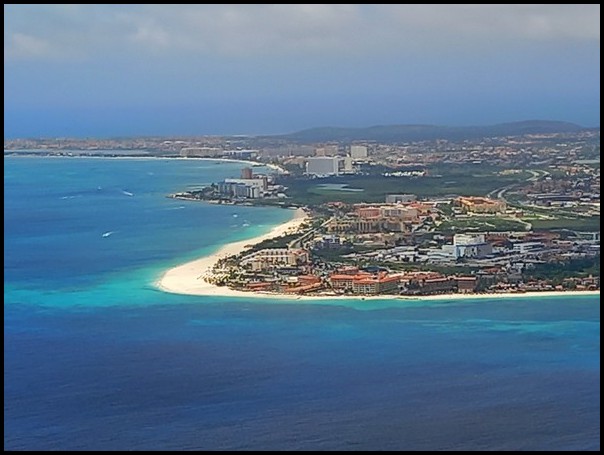
Visiting Aruba
Visiting Aruba is pretty easy and straight-forward, especially for Americans. The island is relatively close to the US, making flights fairly short and inexpensive, particularly from the east coast and southern states.
Making things even easier, Americans and travelers from many other countries do not need a visa for visits up to 30 days. On the other hand, nowadays a negative PCR test must be taken within 72 hours of the flight and an online Aruba arrivals form must be filled out. An onward or return trip is also required, though not necessarily checked.
Aruba is safe, peaceful and laid-back, with friendly, welcoming locals who appreciate the tourist trade. Aruba is also generally outside the seasonal hurricane belt, which often blasts other Caribbean islands.
All sorts of accommodations are available, from large luxury beachside hotels to rental apartments, vacation homes and AirBnB options.
However, Aruba is very expensive and not really a feasible destination for budget travelers unless they can find a house-sitting, work-exchange or volunteer position that will cover at least their accommodation.
Nearly everything on Aruba is expensive, from accommodation to groceries that cost 50-100% more than in the USA, to taxi and car rentals, to restaurants and bars. The only relatively inexpensive things are admission to some attractions and museums. Otherwise, visitors should plan on spending more than they would in the US.
I’ll be writing a more detailed article or two about visiting Aruba, with tips, cost-cutting advice and other useful information.
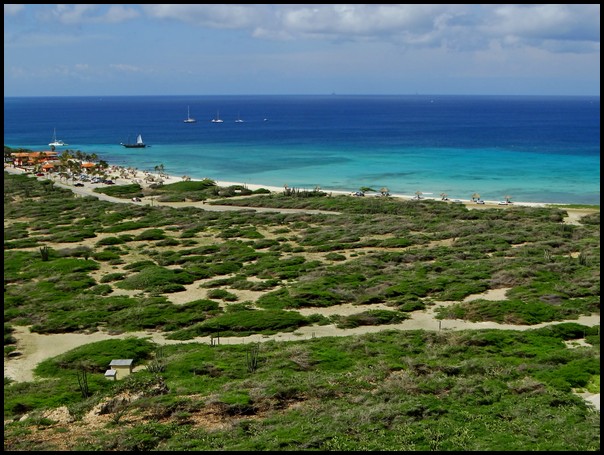
Things to See & Do in Aruba
Considering how small Aruba is, it’s rather astounding how many things there are to do and how many interesting places there are to visit on the island. Following is a brief rundown. I’ll be writing a lot more about all the diverse things to see & do on Aruba in a few more articles, coming up soon.
Not surprsingly, most people visit Aruba for the beaches: sand, sea and sun. With the island’s many stunning, world-acclaimed powdery white sand beaches, calm clear seas and never-ending sunshine, it’s no wonder.
Naturally, vacationers can enjoy all the usual beach activities: suntanning, swimming, walking & jogging, relaxing in the shade, reading and so on. Besides that, there’s yoga, wind surfing, kite surfing, snorkeling, diving, sailing, SUP, sea kayaking and motorized water activities like jetskiing, water skiing, parasailing, banana boats, charter boats, fishing, sunset tours & so on.
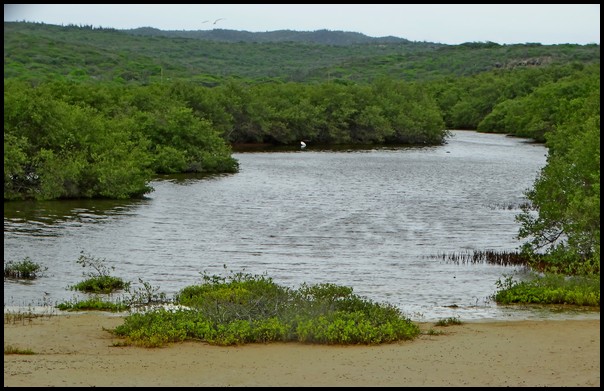
Land-based activities include hiking, bicycling, horseback riding and driving ATVs, jeeps, 4WDs or joining various small group tours.
The island has an amazing diversity of land features and natural habitats, all of which can be explored individually or in group tours. Besides offering many different types of beaches, Aruba has tall cactus forests, sand dunes, rocky shorelines, tall cliffs, rock formations, inland lagoons, a bird sanctuary, salt flats, Arikok National Park, caves, natural sea water pools, natural rock bridges and a sole perfectly-conical hill of volcanic origin, Whew!
There’s also a butterfly sanctuary, a donkey sanctuary, an animal farm and an ostrich farm.
On the history & culture side, there’s California Lighthouse, the capital ‘city’ of Oranjestad with its pastel-colored historic Dutch colonial buildings. museums, shopping, art galleries, street art and murals, street cars & trolleys. There’s also Fort Zoutman, an aloe vera factory/museum and an abandoned 1900s gold mine.
Aruba is also huge on nightlife, with dozens of casinos, beachside bars, dance clubs and restaurants, all of which are open nightly, year-round.
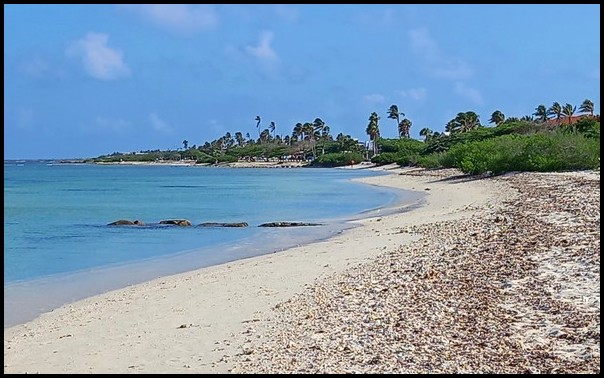
Summary
Aruba is a beautiful little island nation in the Caribbean. It’s a famous beach vacation destination, especially for Americans. The island has interesting history and culture as well as great natural diversity. Despite its small size, the island offers dozens and dozens of diverse things to see and do.
I’m on Aruba now and will be here another six weeks, exploring & sharing photos, interesing information, tips and advice for this gorgeous sand-rimmed Caribbean island. So stay tuned !
========================
You might also like:
25 Highlights of Travel in Central America
======================






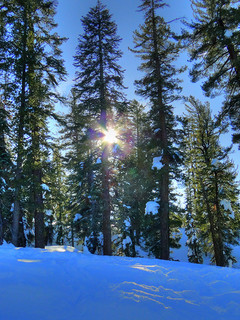

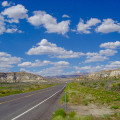
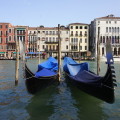

 Hi! I'm Lash, an American nomadic world traveler who's been traveling solo since 1998. I’m passionate about traveling the world nomadically and then sharing it all with you. I hope to inspire you to travel the world, to entertain you with tales from the road, and to help you reach your travel dreams. Welcome!
Hi! I'm Lash, an American nomadic world traveler who's been traveling solo since 1998. I’m passionate about traveling the world nomadically and then sharing it all with you. I hope to inspire you to travel the world, to entertain you with tales from the road, and to help you reach your travel dreams. Welcome! 




3 pings
All About the Caribbean 'ABC Islands' - LashWorldTour
2021/09/23 at 7:18 am (UTC 8) Link to this comment
[…] Introduction to Aruba […]
Natural Aruba: All the Best Nature Places & Activities on the Island - LashWorldTour
2021/10/06 at 6:20 am (UTC 8) Link to this comment
[…] Introduction to Aruba […]
10 Money Saving Tips for Aruba - LashWorldTour
2021/10/13 at 4:17 am (UTC 8) Link to this comment
[…] My Introduction to Aruba […]